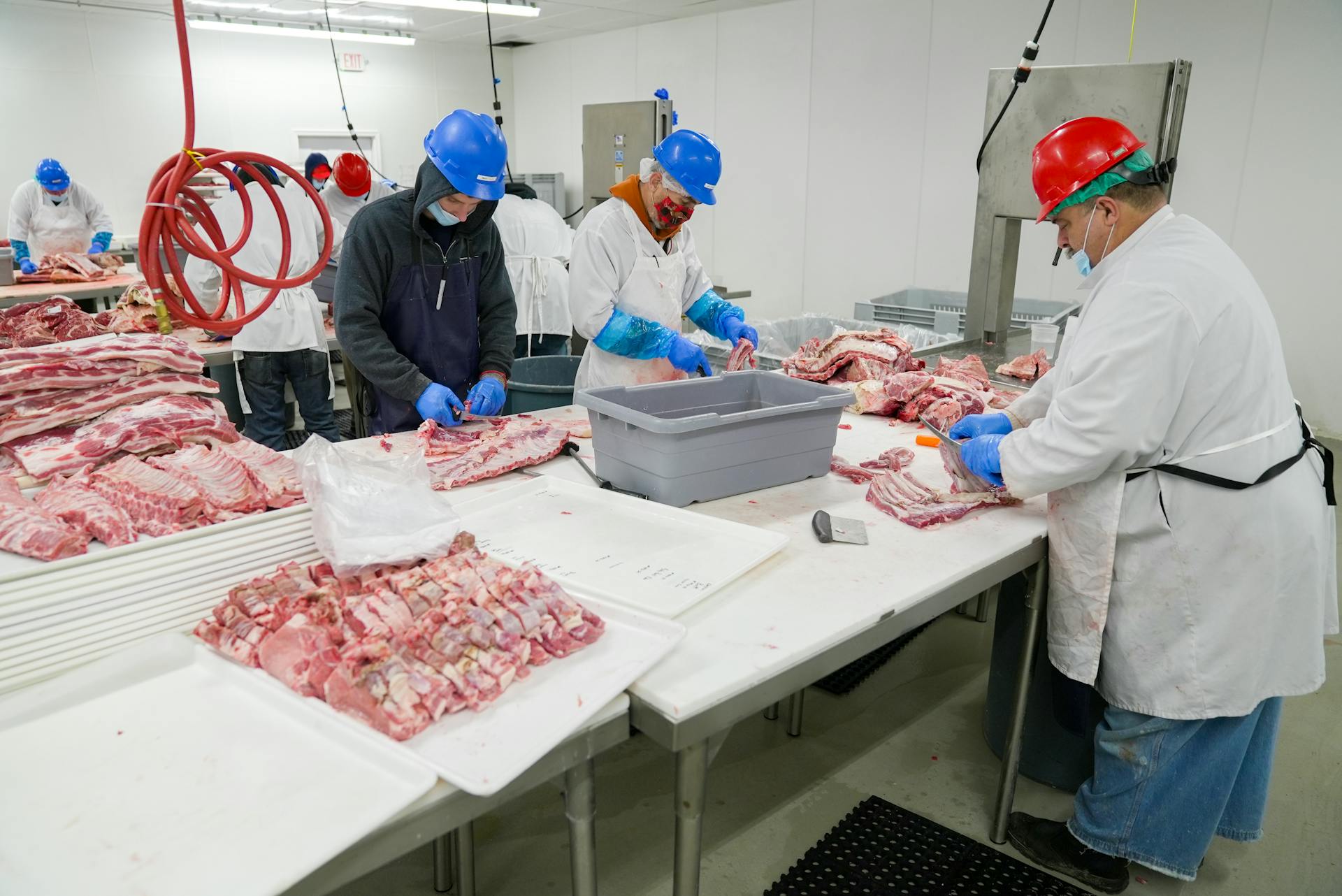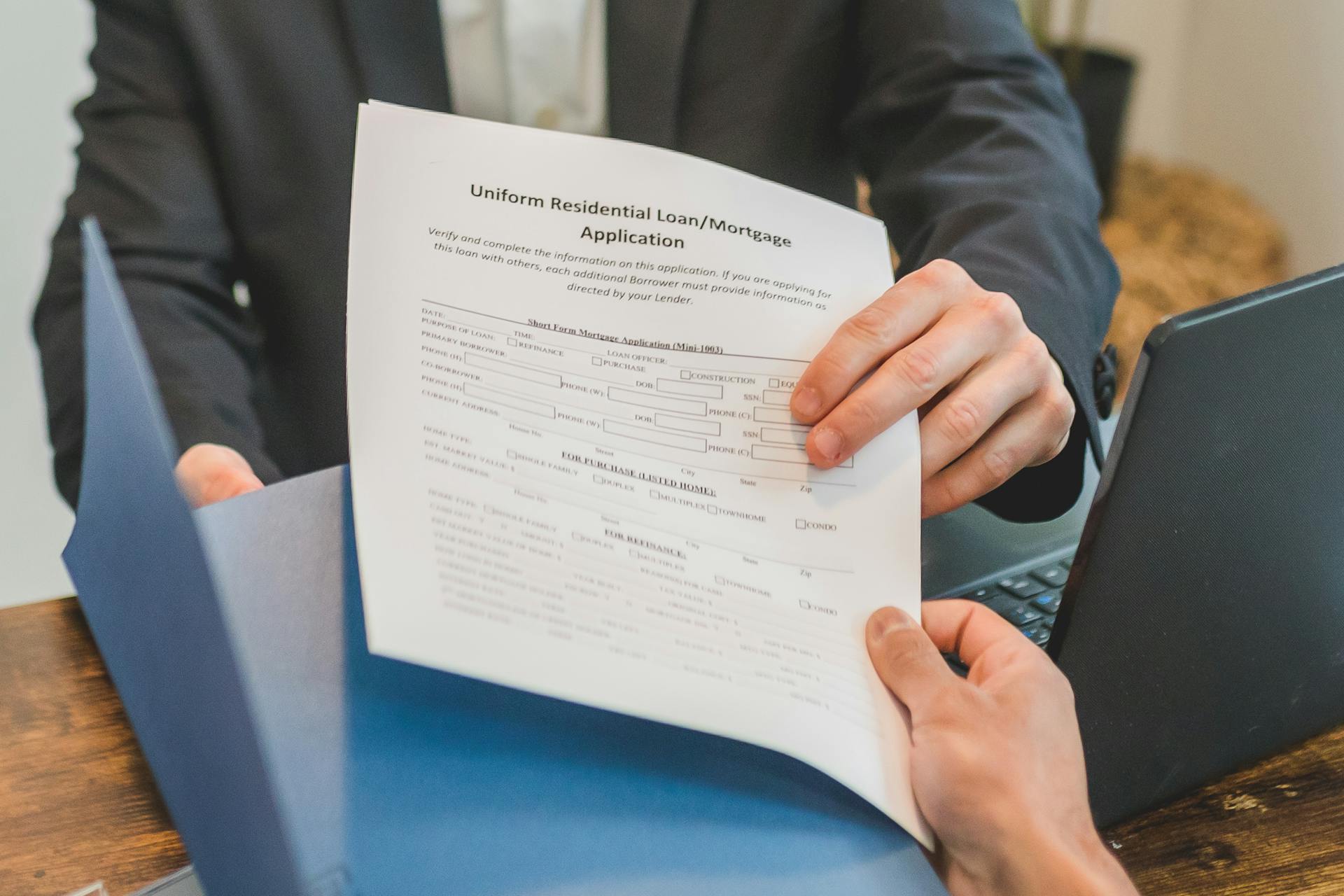
Getting a USDA home loan can be a bit of a challenge, but it's definitely doable with the right information. To qualify, you'll need to meet the income and property requirements, which vary by area.
The good news is that the USDA doesn't have a minimum credit score requirement, but you'll still need to have a decent credit history. This means paying bills on time and keeping credit card balances low.
To be eligible for a USDA home loan, you'll need to have a moderate income, which is typically defined as 115% of the area median income. This means that if you're buying a home in a high-cost area, you may still qualify even if your income is higher than the median.
Your home must also be located in a rural area, which is defined by the USDA as any area outside of a city or town with a population of 35,000 or more.
Discover more: How Much Usda Mortgage Can I Qualify for
Types of USDA Loans
There are three main types of USDA home loans to consider. The USDA guarantees a mortgage issued by a participating local lender, allowing borrowers to qualify for low mortgage interest rates without a down payment.
You'll have to pay an upfront fee of 1% and an annual fee of 0.35% of the loan balance, which is amortized across monthly payments. This typically costs less than traditional PMI.
Direct loans are issued by the USDA for low- and very low-income applicants who are without safe housing or can’t access a traditional home loan. Income thresholds vary by region.
These loans offer terms of up to 38 years and interest rates as low as 1% with subsidies.
Here's an interesting read: Share Secured Loan Rates
USDA
USDA loans can be a great option for those looking to purchase a home with little to no down payment. They can be easier to qualify for than other types of mortgages.
You might be eligible for a USDA loan if you earn a moderate income and aren't buying a home in a big city. This zero-down program can be a game-changer for first-time homebuyers.
Discover more: Home Mortgage Loans down Payment
One of the best features of the USDA program is that there is no down payment requirement. This means you can borrow up to the home's appraised value, plus the USDA upfront guarantee fee.
USDA loans are a true no-money-down loan, making them an attractive option for those with little savings. The USDA program is the only mortgage, besides the VA mortgage, that allows this type of financing.
Here are some key USDA loan facts to keep in mind:
- USDA loans are flexible and have a smooth transaction process.
- USDA loan limits apply, but they can vary depending on the location.
- Reasons for denial include income and credit score requirements.
- USDA loans work by allowing borrowers to borrow up to the home's appraised value.
- Financing the upfront guarantee fee is optional.
Best Lenders
USDA loans can be a great option for homebuyers in eligible areas, but not many banks offer them. Among those that do, some lenders stand out from the rest.
Not many banks offer USDA loans, making it a limited market for lenders to compete in. However, some lenders have made a name for themselves by offering these loans.
We selected our standout picks from the lenders that offer USDA loans, and they are worth considering.
Consider reading: Usda Home Loan Lenders
Home Qualification
To qualify for a USDA home loan, you'll need to meet certain requirements. The property must be located in a rural area, which is defined as a location with a population of 10,000 or less in areas that are "rural in character" or "in open country".
To find a property eligible for a USDA loan, you can visit the USDA's property eligibility site. The property must also be the prospective buyer's main residence, and the buyer may not own another property within a reasonable distance of the prospective new home.
Your household income cannot exceed 115% of the median income in the county where your new house is located. To find the income limit for your county, consult the USDA map and table. The income limit varies by location and household size.
Here are the income limits for USDA loans:
The USDA also requires a proven history of dependable income and a credit history that demonstrates a reliable ability to repay debts. A credit score of at least 640 is required for streamlined processing, but borrowers without credit history can be evaluated through alternative criteria.
The monthly payment on the loan, including principal, interest, insurance, and taxes, must be 29% or less of the borrower's monthly income. Other monthly debt payments cannot exceed 41% of the borrower's income.
Single Family Housing
To qualify for a Single Family Housing Direct Home Loan, borrowers must meet certain income limits, which vary by county and metro area. These limits can be found on the USDA website.
To be eligible for a Single Family Housing Direct Home Loan, borrowers must also currently be without "decent, safe, and sanitary" housing. This means they must be living in substandard conditions or have other housing needs that are not being met.
To qualify for a Single Family Housing Direct Home Loan, borrowers must be unable to meet the qualifications necessary to obtain another kind of mortgage. This could be due to a poor credit history, income issues, or other financial constraints.
Here are the key requirements for a Single Family Housing Direct Home Loan:
- Meet income limits
- Currently be without "decent, safe, and sanitary" housing
- Be unable to meet the qualifications necessary to obtain another kind of mortgage
- Be a U.S. citizen or eligible noncitizen
Single Family Housing
To qualify for a Single Family Housing Direct Home Loan, you must meet certain income limits, which vary by county and metro area. These limits can be found on the USDA website.
You must also currently be without decent, safe, and sanitary housing. This means you're in need of a new home. If you're already living in a decent home, you won't be eligible for this loan.
Another requirement is that you must be unable to meet the qualifications necessary to obtain another kind of mortgage. This means you've been turned down for other types of loans in the past.
Additionally, you must be a U.S. citizen or eligible noncitizen. If you've been prohibited from federal programs, you won't be eligible for this loan.
Here are the key requirements for a Single Family Housing Direct Home Loan:
- Meet income limits by county and metro area
- Currently be without decent, safe, and sanitary housing
- Unable to meet qualifications for another mortgage
- Be a U.S. citizen or eligible noncitizen
- Not be prohibited from federal programs
Flagstar Bank
Flagstar Bank is a great option for single family housing loans. They offer a wide range of loan options, including conventional, FHA, VA, USDA, jumbo, and renovation loans.
Flagstar Bank's website is easy to use and offers personalized rates. Borrowers can complete most of the closing process online or on their mobile device.
Flagstar Bank issues USDA loans in all 50 US states. They also offer Destination Home Mortgage loans, which require a credit score of 600.
Here are some of the loan options offered by Flagstar Bank:
- Conventional loans with a credit score of 620 and a down payment of 3%
- FHA, VA, and USDA loans with 0% down payment
- Jumbo loans for higher-priced homes
- Renovation loans for home repairs and improvements
Flagstar Bank offers both fixed-rate and adjustable-rate loans. Fixed-rate loans are available with 15-year and 30-year terms, while adjustable-rate loans have a 5-year, 7-year, or 10-year intro period.
On a similar theme: State Bank of India Housing Loan Interest Rate
Pnc Bank
PNC Bank is a solid option for single family housing financing. They offer a range of loan options, including conventional loans, FHA loans, VA loans, and USDA loans.
PNC Bank's loan terms can be tailored to fit your needs, with options for fixed-rate and adjustable-rate mortgages. You can choose a loan term of 10 to 30 years.
The bank's credit score requirement is relatively reasonable, at 620. However, it's worth noting that this may vary depending on the specific loan product you're applying for.
One notable feature of PNC Bank's mortgage offerings is the $5,000 grant available to low-income borrowers who qualify for a USDA direct loan. This grant can be used to cover closing costs or other prepaid fees.
If you're considering a PNC Bank mortgage, be sure to explore their online application process, which allows you to apply for personalized rates. They also offer a Home Insight Planner to help you determine your financial standing and find houses within your budget.
Program Details
USDA home loans offer a no-down-payment option, which means lenders take on 100% of the risk that you'll repay the loan. To mitigate this risk, the USDA charges upfront and yearly mortgage insurance (MI) fees.
The upfront guarantee fee is 1% of the total loan amount, which can be added to the loan and financed over time. This fee is equivalent to the loan amount plus 1%, so if your loan is $150,000, the total amount would be $151,500.
USDA also charges an annual fee of 0.35% of the loan's outstanding balance, divided by 12 and added to the monthly payment. This fee is not private mortgage insurance (PMI), but rather a guarantee fee that serves as a low-cost type of mortgage insurance.
Here's a breakdown of the USDA loan fees:
Program Highlights
The USDA loan program is a great option for those looking to purchase a home with minimal upfront costs. No down payment is required, making it more accessible to first-time homebuyers.
One notable benefit of the USDA loan program is that it doesn't have a maximum loan amount, allowing borrowers to take out larger loans if needed. This can be a significant advantage for those looking to purchase a more expensive home.
The USDA loan program also offers competitive 30-year fixed interest rates, which can provide stability and predictability for borrowers. This can be especially helpful for those who value long-term financial planning.
Another perk of the USDA loan program is that it doesn't have prepayment penalties, meaning borrowers can pay off their loan at any time without facing additional fees. This can be a significant advantage for those who plan to pay off their loan early.
Here are some key highlights of the USDA loan program:
- Moderate income limits apply – based on family size
- No down payment required
- No Prepayment Penalties
- Purchase and Refinance: 1% upfront guarantee fee that can be rolled into the loan
- 0.35%Yearly fee paid monthly
- Competitive 30-year fixed interest rates
- No maximum loan amount
- No limits on cash contributions
- Not restricted to first-time buyers
- The home must be occupied as your permanent residence
Program
The USDA program offers a no down payment option, which means lenders take on 100% of the risk that the customer will repay the loan. To mitigate this risk, USDA charges mortgage insurance (MI), which includes an upfront fee and a yearly fee.
A unique perspective: Cyber Risk Modeling

The upfront guarantee fee is 1% of the total outstanding loan, and this amount can be added to the loan and financed over time. This fee is a one-time payment that can be a significant upfront cost for borrowers.
USDA charges a yearly fee of 0.35% of the loan's outstanding balance, which is divided by 12 and added to the monthly payment made by the borrower. This fee is ongoing and can add up over time.
Here are the key program highlights of the USDA program:
- Moderate income limits apply – based on family size
- No down payment required.
- No Prepayment Penalties.
- Purchase and Refinance: 1% upfront guarantee fee that can be rolled into the loan
- 0.35% Yearly fee paid monthly
- Competitive 30-year fixed interest rates.
- No maximum loan amount.
- No limits on cash contributions.
- Not restricted to first-time buyers
- The home must be occupied as your permanent residence.
Program Details
The USDA loan program offers a range of benefits, but it's essential to understand the program details before applying.
No down payment is required, making it an attractive option for many homebuyers. However, keep in mind that you'll still need to pay a 1% upfront guarantee fee, which can be rolled into the loan.
Moderate income limits apply, and the loan amount is not restricted. The home must be occupied as your permanent residence.

Here are the key program details:
The USDA loan program has no prepayment penalties, and competitive 30-year fixed interest rates are available.
Does Have Limits?
The USDA loan program doesn't impose loan limits, which is great news for homebuyers. This means you can buy a home at any price point, as long as you can qualify for the loan and afford the monthly payments.
Your maximum loan amount will be based on your income and debt-to-income ratio. If you have a lot of existing debt with high payments each month, you'll have less money left over for a mortgage payment, leading to a lower loan amount.
USDA mortgage rates are typically below-market, giving borrowers more buying power. This is especially beneficial for those with a lot of debt or a lower income.
To make the most of this program, it's essential to shop around for your lowest rate. Compare quotes from at least three USDA-approved lenders to ensure you're getting the best deal available.
Your lender will require you to provide at least two years of tax returns to determine your eligibility and loan limit. This will help them accurately assess your income and debt situation.
If this caught your attention, see: Home Loan Payoff Amount
Closing Costs
Closing costs can be a significant expense for homebuyers, but there are options to consider. Closing costs are associated with every type of loan, and USDA loans are no exception.
These costs can total up to thousands of dollars, which is a substantial amount. Some examples of closing costs include title insurance, recording fees, and homeowner's insurance.
The good news is that the USDA program allows for flexibility in paying closing costs. The buyer may pay them at the time the loan is closed, receive a gift to cover the costs, or negotiate with the seller to pay part or all of the costs.
If the buyer intends to negotiate with the seller, it's essential to speak with a loan officer experienced with the program to understand the limits. The seller can pay up to a certain amount, which varies depending on the situation.
Here are the three options for paying closing costs according to the USDA program:
- The buyer may pay them at the time the loan is closed.
- The buyer may receive a gift to cover the closing costs.
- The seller may pay part or all of the closing costs.
If the buyer receives a gift to cover the closing costs, it's recommended that the gift be accompanied by a letter explaining the gift and the nature of the relationship between the buyer and the giver of the gift. This is a requirement of the USDA program.
Worth a look: Usda First Time Home Buyer Loan
Frequently Asked Questions
What is the downside to a USDA loan?
USDA loans have strict eligibility requirements and come with lifetime mortgage insurance premiums, which may limit who can qualify and increase long-term costs
What would cause a USDA loan to be denied?
A poor credit score, with a score below 640 or indicating late payments, can cause a USDA loan to be denied. This includes factors like collections accounts, delinquent accounts, and excessive recent inquiries.
How long does USDA approval take?
USDA loan approval typically takes 30-45 days after signing a purchase agreement, depending on the speed of document completion and submission. Faster processing can lead to quicker final approval and closing.
Featured Images: pexels.com


